Western Center For Archaeology and Paleontology
[All images of The Western Center for Archaeology and Paleontology were taken by Arthur Kesler and are used here with permission.]
Before Gaby and I left California for New Zealand I worked at the San Bernardino County Museum as a field paleontologist, collecting fossils from the field. In the mid to late 1990s our division worked on a large earthmoving project just south of Hemet, CA. The project was to construct two large earth fill dams for a large water reservoir. During the course of construction (1993-2001) our field crew found and excavated a veritable treasure trove of Ice Age fauna, similar to what is found at the La Brea Tar Pits at the Page Museum in downtown Los Angeles.
Our team excavated and recovered several impressive sites which contained semi-articulate specimens. These finds were carefully stabilized and preserved. After construction of Diamond Valley Lake was completed, the Metropolitan Water District, along with a few inspirational individuals, decided to pursue the construction of a new natural history museum devoted to the natural history of the surrounding area, including fossil finds recovered during the construction of the reservoir. This grand concept led to the planning and construction of Western Center for Archaeology and Paleontology.
The folks at the Western Center wanted to put on display several of the larger specimens, complete with mounted replicas. Again, the San Bernardino County Museum Geological Sciences division staff was called upon to make this happen. Through the hard work and creative minds of folks like Michael Stokes, Craig Manker, Quintin Lake, James Bowden, and myself, our team was able to create replicas of these fine specimens. After many months of planning and problem solving, we got the job done.
I have had the great fortune of witnessing this process come full circle: from the search for fossils through the excavation and recovery, the preparation and stabilization, the reconstruction, and finally, the replication. The Western Center for Archaeology and Paleontology in Hemet has recently opened its doors to museum visitors. Since I don't know when I will be in Southern California again, I asked my parents to travel to the museum and snap a few photos of the displays.

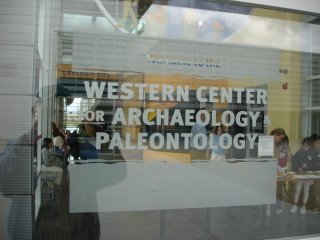
In 1995, Senior Field Paleontologist Quintin Lake discovered the first largely intact specimen from the reservoir. Thankfully, much of the construction in the area was completed by the contractors, which allowed crews to excavate the find without interrupting their work. This was an impressive find, as it appears to be the largest Mastadon found on the West Coast of the United States. Most impressive about this specimen was that the skull was mostly intact.

The cast of Max's skull is in the mount of the animal, while the original skull is on display beside it.

Quintin's impressive find highlighted the potential for great discoveries in the area. As construction progressed the field crew continued to find many more fossils. Then, in 1997, I found another impressive site: not just a single mastodon, but a collection of at least 6 different large mammals - camel, bison antiqua and bison latifrons, among others. The mastodon, named "Little Stevie," is one of the most intact mastodons found on the west coast with around 60% of the animal found.

Excavation of the "Little Stevie" site took three weeks. There is a display which adds some detail to what is involved in the excavation of a fossil site.

Carefull attention to detail in the field can offer valuable insight into reconstruction of what the area might have been like thousands of years before.

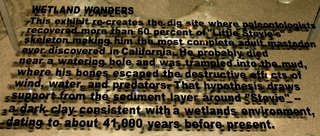
My Mother enjoys the "Little Stevie" display!
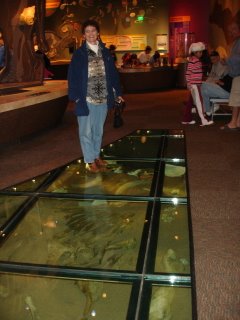

The field crew again continued to recover large numbers of great fossils from the reservoir. The next "big" find was when I found what turned out to be a mammoth which is caled "Zena." Astonishingly, the skull of this individual was found to be mostly intact (along with the tusks). The field crew had a great time overcoming the challenges of recovering this specimen.

Again, the original skull is on display next to the mounted replica.

"Zena" mounted for all to enjoy.

There were of course other animals found as well. This mount of a Sloth is similar to the species of incomplete sloth specimens found during the project.

"Zena" and "Max" stand side by side for visitors to enjoy.

Behind The Scenes
What may not be evident from the finished museum displays is the hard work and devotion of the entire field crew. These folks worked tirelessly for over seven years, diligently searching for fossils which may have been exposed by construction. It is the field crew which made all this possible, for they are the ones who showed determination and perserverence in the search and recovery of these splendid specimens. These are the folks who had the knowledge and desire to recover these awesome fossils for future generations. They are the ones who laboured hard and long, and deserve to be recognized for their efforts. I wish to thank all those folks who were a part of our field crew at the musuem.
I would like to extend a special thanks to my good friend and former colleague Quintin Lake, who taught me much about looking for fossils and how to recover them. He continues to be an inspiration for me.

I would also like to thank Craig Manker, who picked up where others had left off in order to make sure this project would get finished. He stuck in there for the long haul, devoting countless hours and working through much frustration to complete the task at hand. I congratulate you Craig on a job well done.

I have never worked with such a wonderful group of friendly, eccentric folks who love what they do.

My last great highlight before leaving the San Bernardino County Museum was to be able to make one of the first successful casts of a tusk!
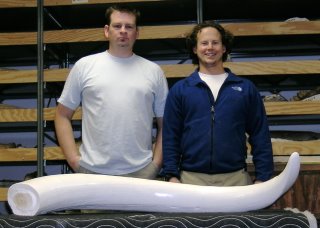
I would also like to thank Jim Bowden, whose expertise helped to replicate the colours of the original specimens. His great skill definitely shows in how well the casts came out. I am sorry I do not have a photo of you to post here Jim, but I wanted to thank you for your efforts none the less.
If you ever find yourself wandering about around Southern California, I would encourage you to make a stop at the Western Center for Archaeology and Paleontology in Hemet and discover what might be found beneath your feet!
Before Gaby and I left California for New Zealand I worked at the San Bernardino County Museum as a field paleontologist, collecting fossils from the field. In the mid to late 1990s our division worked on a large earthmoving project just south of Hemet, CA. The project was to construct two large earth fill dams for a large water reservoir. During the course of construction (1993-2001) our field crew found and excavated a veritable treasure trove of Ice Age fauna, similar to what is found at the La Brea Tar Pits at the Page Museum in downtown Los Angeles.
Our team excavated and recovered several impressive sites which contained semi-articulate specimens. These finds were carefully stabilized and preserved. After construction of Diamond Valley Lake was completed, the Metropolitan Water District, along with a few inspirational individuals, decided to pursue the construction of a new natural history museum devoted to the natural history of the surrounding area, including fossil finds recovered during the construction of the reservoir. This grand concept led to the planning and construction of Western Center for Archaeology and Paleontology.
The folks at the Western Center wanted to put on display several of the larger specimens, complete with mounted replicas. Again, the San Bernardino County Museum Geological Sciences division staff was called upon to make this happen. Through the hard work and creative minds of folks like Michael Stokes, Craig Manker, Quintin Lake, James Bowden, and myself, our team was able to create replicas of these fine specimens. After many months of planning and problem solving, we got the job done.
I have had the great fortune of witnessing this process come full circle: from the search for fossils through the excavation and recovery, the preparation and stabilization, the reconstruction, and finally, the replication. The Western Center for Archaeology and Paleontology in Hemet has recently opened its doors to museum visitors. Since I don't know when I will be in Southern California again, I asked my parents to travel to the museum and snap a few photos of the displays.


In 1995, Senior Field Paleontologist Quintin Lake discovered the first largely intact specimen from the reservoir. Thankfully, much of the construction in the area was completed by the contractors, which allowed crews to excavate the find without interrupting their work. This was an impressive find, as it appears to be the largest Mastadon found on the West Coast of the United States. Most impressive about this specimen was that the skull was mostly intact.

The cast of Max's skull is in the mount of the animal, while the original skull is on display beside it.

Quintin's impressive find highlighted the potential for great discoveries in the area. As construction progressed the field crew continued to find many more fossils. Then, in 1997, I found another impressive site: not just a single mastodon, but a collection of at least 6 different large mammals - camel, bison antiqua and bison latifrons, among others. The mastodon, named "Little Stevie," is one of the most intact mastodons found on the west coast with around 60% of the animal found.

Excavation of the "Little Stevie" site took three weeks. There is a display which adds some detail to what is involved in the excavation of a fossil site.

Carefull attention to detail in the field can offer valuable insight into reconstruction of what the area might have been like thousands of years before.


My Mother enjoys the "Little Stevie" display!


The field crew again continued to recover large numbers of great fossils from the reservoir. The next "big" find was when I found what turned out to be a mammoth which is caled "Zena." Astonishingly, the skull of this individual was found to be mostly intact (along with the tusks). The field crew had a great time overcoming the challenges of recovering this specimen.

Again, the original skull is on display next to the mounted replica.

"Zena" mounted for all to enjoy.

There were of course other animals found as well. This mount of a Sloth is similar to the species of incomplete sloth specimens found during the project.

"Zena" and "Max" stand side by side for visitors to enjoy.

Behind The Scenes
What may not be evident from the finished museum displays is the hard work and devotion of the entire field crew. These folks worked tirelessly for over seven years, diligently searching for fossils which may have been exposed by construction. It is the field crew which made all this possible, for they are the ones who showed determination and perserverence in the search and recovery of these splendid specimens. These are the folks who had the knowledge and desire to recover these awesome fossils for future generations. They are the ones who laboured hard and long, and deserve to be recognized for their efforts. I wish to thank all those folks who were a part of our field crew at the musuem.
I would like to extend a special thanks to my good friend and former colleague Quintin Lake, who taught me much about looking for fossils and how to recover them. He continues to be an inspiration for me.

I would also like to thank Craig Manker, who picked up where others had left off in order to make sure this project would get finished. He stuck in there for the long haul, devoting countless hours and working through much frustration to complete the task at hand. I congratulate you Craig on a job well done.

I have never worked with such a wonderful group of friendly, eccentric folks who love what they do.

My last great highlight before leaving the San Bernardino County Museum was to be able to make one of the first successful casts of a tusk!

I would also like to thank Jim Bowden, whose expertise helped to replicate the colours of the original specimens. His great skill definitely shows in how well the casts came out. I am sorry I do not have a photo of you to post here Jim, but I wanted to thank you for your efforts none the less.
If you ever find yourself wandering about around Southern California, I would encourage you to make a stop at the Western Center for Archaeology and Paleontology in Hemet and discover what might be found beneath your feet!
Labels: Craig, Little Stevie, Max, Quintin, San Bernardino County Museum, Steven, Western Center for Archaeology and Paleontology, Zena

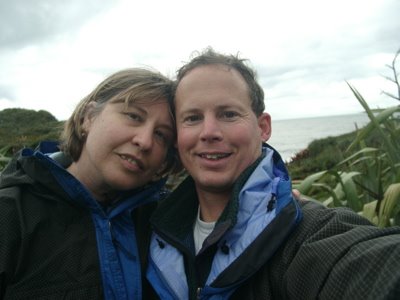

5 Comments:
Next time I'm in Hemet, I know where I'm going.
Hey Stevie -
I would have sent this to you directly if you had an e-mail on your blog page.
Too bad your parents didn't tell you the rest. Not a single SBCM tag is visible on any fossil, all references to us and the archaeologists omit what institution we're with, and they've got a big mural on the west wall showing images of our fossils on boxes labeled WCAP. Basically they claim credit for everything that the museum and the archaeologists did by omitting any mention of it. Eric and I went to the opening weekend and I was so ticked off at the Western Center taking credit for what the museum had done that I had to leave before I took chunks out of the director. Nice exhibits, but the WCAP has been really slimy about giving credit where it's due.
E-mail Eric at the museum and he can bounce it to me if you want more dirt.
- Kim Scott
For some reason none of this surprises me. When the Western Center For Archaeology and Paleontology (WCAP) website first went up I took a good look at the content and most interesting was what was missing on their website: Any mention of the San Bernardino County Museum! The very institution which had the foresight to suspect the existance of fossils in the area, not to mention the many years of collection, preservation, and curation of such a fine example of fossils. Visitors to the WCAP may even get the impression it was actually WCAP staff that made the discoveries, collected the specimens, stabilized and reconstructed them, curated and perhaps even cast the replicas!
For some reason none of this surprises me. When the Western Center For Archaeology and Paleontology (WCAP) website first went up I took a good look at the content and most interesting was what was missing on their website: Any mention of the San Bernardino County Museum! The very institution which had the foresight to suspect the existance of fossils in the area, not to mention the many years of collection, preservation, and curation of such a fine example of fossils. Visitors to the WCAP may even get the impression it was actually WCAP staff that made the discoveries, collected the specimens, stabilized and reconstructed them, curated and perhaps even cast the replicas!
The previous comment was actually worth saying twice!
Post a Comment
<< Home